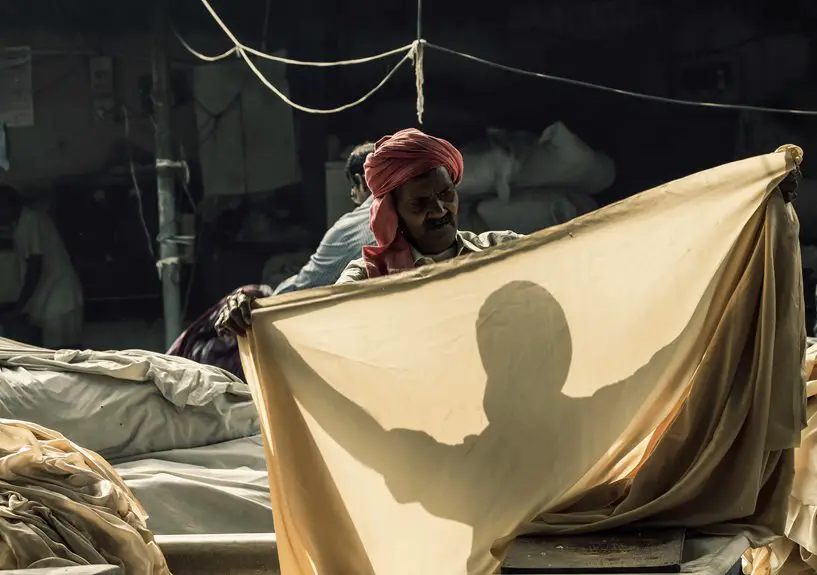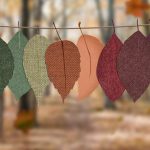To start fabric dyeing, choose the right dye for your fabric—fiber-reactive for cotton, acid dyes for silk or wool, and disperse dyes for synthetics. Prep your fabric by washing and possibly mordanting it to help the color stick. Gather tools like gloves, measuring spoons, and a dye container. Follow proper dye mixing and soaking steps for even color. Care for your dyed pieces with gentle washing and avoid sun fading. Keep going to explore detailed techniques and tips.
Table of Contents
Key Takeaways
- Choose the correct dye type based on fabric fiber for optimal color and durability.
- Thoroughly wash and, if needed, mordant fabric to ensure even dye absorption.
- Mix dye following instructions and maintain appropriate water temperature for best results.
- Fully submerge and gently stir fabric in dye bath to achieve consistent coloring.
- Care for dyed fabrics by washing in cold water, avoiding bleach, and air-drying away from sunlight.
Types of Fabric Dyes and Their Uses
Although fabric dyeing can seem complex, understanding the types of dyes available helps you choose the right one for your project. You’ll find several common types: fiber-reactive, acid, direct, and disperse dyes.
Fiber-reactive dyes work best with natural fibers like cotton, bonding chemically for vibrant, lasting colors. Acid dyes are ideal for protein fibers such as silk and wool, offering rich shades with good wash-fastness.
Direct dyes suit cellulose fibers but tend to fade faster and are less vibrant. Disperse dyes are your go-to for synthetic fabrics like polyester, as they penetrate the fibers effectively.
Knowing these differences means you can pick the dye that matches your fabric, ensuring better results and color durability every time you dye.
Preparing Fabric for Dyeing
Before you start dyeing, you need to prepare your fabric properly to secure even color absorption and lasting results.
First, wash the fabric thoroughly to remove any dirt, oils, or sizing that might block the dye from penetrating evenly.
Start by washing your fabric to eliminate dirt and oils for even dye absorption.
Next, if your fabric is cotton or another natural fiber, soak it in a mordant solution if required; this helps fix the dye and enhances colorfastness.
Finally, make sure the fabric is damp but not dripping wet before you begin dyeing, as moisture helps the dye spread uniformly.
Here’s a quick checklist to prepare your fabric:
- Wash to remove impurities and finishes.
- Apply mordant if needed for your fabric type.
- Keep fabric evenly damp before dyeing.
These steps set the stage for vibrant, even dyeing results.
Essential Tools and Materials for Dyeing
Once your fabric is prepped and ready, gather the right tools and materials to guarantee a smooth dyeing process.
You’ll need dye powder or liquid, depending on your chosen method, and a large plastic or stainless steel container to mix your dye. Rubber gloves protect your hands, while a stirring stick or spoon helps blend the dye evenly.
Have measuring cups or spoons on hand to verify accurate dye amounts. Prepare your workspace with plastic covers or newspapers to avoid stains.
Don’t forget to have access to water—either a sink or buckets—for rinsing and soaking. Finally, keep clean towels nearby for drying and handling wet fabric safely.
With these essentials, you’ll be set to dye your fabric efficiently and effectively.
Step-by-Step Fabric Dyeing Techniques
Dyeing fabric involves a few key steps that you can easily follow to achieve vibrant, even colors.
First, prepare your fabric by washing it to remove any finishes that might block the dye.
Begin by washing your fabric to eliminate any finishes that could prevent dye absorption.
Next, mix your dye according to the package instructions, ensuring you use the right temperature water for the fabric type.
Finally, submerge your fabric fully in the dye bath, stirring gently to promote even absorption.
- Pre-wash and wet your fabric to remove sizing and help the dye spread evenly.
- Mix dye thoroughly with water, adjusting temperature as needed for your fabric.
- Dye fabric evenly by immersing it completely and stirring occasionally for consistent color.
Following these steps sets you up for successful, vibrant dye results.
Tips for Maintaining and Caring for Dyed Fabrics
Although the colors may look perfect fresh from the dye bath, you’ll need to take specific steps to keep your fabric vibrant and prevent fading.
First, always wash dyed fabrics in cold water with a mild detergent to preserve color. Avoid bleach and harsh chemicals that can strip dye.
When drying, air-dry your fabric away from direct sunlight, which can cause fading. If you use a dryer, choose a low-heat setting.
Store your dyed items in a cool, dark place to maintain color intensity.
Finally, try to wash dyed fabrics separately the first few times to prevent color transfer.
Frequently Asked Questions
Are Natural Dyes Better for the Environment Than Synthetic Dyes?
You’ll find natural dyes generally better for the environment since they’re biodegradable and come from renewable sources. However, they still require water and resources, so using them responsibly is key to minimizing environmental impact.
How Does Fabric Dyeing Impact Water Usage and Pollution?
You’ll use tons of water in fabric dyeing, and that water often carries harmful chemicals into rivers. If you don’t manage waste properly, you’ll contribute to pollution and harm aquatic life. Choose eco-friendly methods!
Can Fabric Dyeing Cause Allergic Reactions or Skin Sensitivity?
Dyeing fabrics can sometimes be a double-edged sword; you might develop allergic reactions or skin sensitivity from harsh chemicals. Always test new clothes on a small skin patch to avoid unexpected irritation or discomfort.
What Historical Cultures Influenced Modern Fabric Dyeing Techniques?
You’ll find that ancient Egyptians, Indians, and Chinese cultures influenced modern fabric dyeing techniques. They developed natural dyes and intricate methods, which you still see reflected in today’s vibrant, diverse textile designs and processes.
How Do Fabric Dyes Affect the Texture and Strength of Materials?
Dyeing fabric is like painting a canvas; you’ll notice dyes can soften or stiffen fibers, sometimes weakening the material’s strength. But with the right dye and technique, you can keep your fabric both vibrant and durable.
- Creating Custom Stencils for Bleach Tie-Dyeing - July 14, 2025
- The Role of Resist in Tie-Dye and Shibori - July 14, 2025
- How to Pre-Wash Fabrics for Optimal Tie-Dye Results - July 14, 2025




